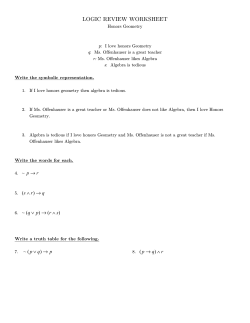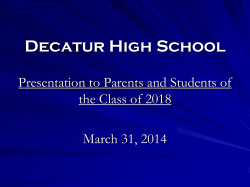
5th to 6th grade registration PowerPoint 2014-2015
Welcome to Julius West Middle School Agenda • • • • • • Welcome to Julius West ! JW Overview IB Middle Years Programme overview 6th grade schedule Course offerings and registration process Additional information and resources Gallup - Student Results - 2013 Hope - 57% Engagement – 58% Well-being – 70% Hope - by Grade 5 4.5 4 3.5 3 2.5 2 1.5 1 0.5 0 4.4 4.44 4.38 6th 7th 8th Engagement 5 4.5 4 3.5 3 2.5 2 1.5 1 0.5 0 4.21 4.16 3.99 6th 7th 8th Well-being 10 9 8.61 8.7 8.54 6th 7th 8th 8 7 6 5 4 3 2 1 0 Gallup Survey – Staff Results Admin. ILT Departments JW Teams Supporting Services Gallup Comparisons Know what’s Development Materials Opportunity Recognition expected Cares Prof. Gallup Comparisons 5 4.4 4.5 4 4 4 4.2 4.14.1 3 4 3.9 3.6 3.5 3.4 3.5 4.3 4.2 4 3.9 3.63.6 3.5 3.4 3 3 JW 2.5 MCPS.MS MCPS.All 2 1.5 1 0.5 0 7 Opinions Matter 8 9 10 11 12 overall Purpose Quality Best Friend My Progress Learn/Grow Clear Commitment A five year program that encourages critical thinking with a global perspective Page 10 Who is in IB? Page 11 What is IB? Page 12 Where is IB? Page 13 When • • • • • • • • MCPS Subjects English World Languages Social Studies Technology Sciences Mathematics Arts Physical Education Page 14 • • • • • • • • Middle Years Programme Language and Literature Language Acquisition Individuals and Societies Design Sciences Mathematics Arts Physical and Health Education Why IB? The overall goal of the IB Middle Years Programme is to develop students who will be: life-long learners critical thinkers responsible global citizens Page 15 How do we IB? For more information: Nancy Deprey, Coordinator Nancy_C_Deprey@mcpsmd.org 301-279-3979 Page 16 A 6th Grade Sample Schedule 7:50 Warning Bell Period JAG 1 2 3 Lunch 4 5 6 7 2:40 Class Special Activity Academic class Academic class Arts or PE class 10:46 – 11:16 Academic class Academic class Arts or PE class Academic class Dismissal each class is 47 minutes long Required Classes Required Classes ► English (Language and Literature) ► Mathematics ► Social Studies (Individuals and Society) ► Investigations in Science 6 ► Physical Education /Health Education JW Mathematics Offerings Sixth Grade Math 6 2.0 Seventh Grade Math 7 2.0 IM 2.0 Compacted 7/8 IM Algebra 1 2.0 Eighth Grade Math 8 2.0 Ninth Grade Algebra 1 2.0 Algebra 1 with Related Geometry Algebra 1 2.0 Honors Geometry 2.0 Honors Geometry 2.0 Honors Algebra 2 Mathematics Offerings JW 9 Algebra 1 2.0 Algebra 1 2.0 and Related Geometry Honors Geometry 2.0 Honors Algebra 2 10 Geometry Honors Geometry 2.0 Double Period Geometry 11 Algebra 2 Precalculus Honors Algebra 2 Honors Precalculus Bridge to Algebra 2 Quantitative Literacy AP Calculus Honors Precalculus AP Statistics AP Statistics Honors Precalculus Algebra 2 Precalculus Algebra 2 Honors Algebra 2 12 AP Calculus Calculus with Applications College-Level Math Courses That Lead To College and Career Readiness * Including MCPS enrichment and acceleration opportunities ** Investigations in Math *** Advanced Placement Calculus, Advanced Placement Statistics, or other college-level courses Percent of Content Percent of Content MCPS and Common Core Strand Comparison Current MCPS Curriculum Number Algebra Geometry Measurement Statistics Probability Final Common Core Standards Number Algebra Geometry Measurement Statistics Probability Curriculum 2.0 2001 Math Program 2012 Math Program Backmapped from AP Aligned to internationally driven standards Broad focus—multiple topics per grade/course More focused—fewer topics per grade/course Emphasis on covering content—pacing Emphasis on deep understanding—proficiency Topics repeated yearly— spiraling Topics taught to mastery— increased depth and application Acceleration by grade-level skipping—driven by targets Acceleration/Enrichment— based on individual student needs Emphasis on student engagement and projectbased learning Topics of Study in Current Math 6: Graphing Data and Analyzing Statistics • Choices in data collection and representation affect their interpretation and use. Decimal Operations and Applications • • • • Selection of standard measurement tools and units depend on the real world. Computational estimations produce approximate results. Multiplication does not always make larger and division does not always make smaller. Fractions, decimals, and percents can be used interchangeably. Geometry • • • Relationships exist among the angles, side, lengths, perimeters, and areas of two-dimensional figures. Geometric figures can change position and maintain the same attributes on a coordinate plane. Geometric relationships exist between two-dimensional and three dimensional figures. Algebra, Patterns and Functions • • Patterns and relationships can be represented graphically, numerically, symbolically, and verbally. Algebraic representations can be use to solve real world problems Probability • • Probability is the mathematics of chance. Sampling affects the relationship between experimental and theoretical probability. Topics of Study in Math 2.0: * Ratios and Proportional Relationships Understand ratio concepts and use ratio reasoning to solve problems. The Number System Apply and extend previous understandings of multiplication and division to divide fractions by fractions. Multiply and divide multi-digit numbers and find common factors and multiples. Apply and extend previous understandings of numbers to the system of rational numbers. Expressions and Equations Apply and extend previous understandings of arithmetic to algebraic expressions. Reason about and solve one-variable equations and inequalities. Represent and analyze quantitative relationships between dependent and independent variables. Geometry Solve real-world and mathematical problems involving area, surface area, and volume. Statistics and Probability Develop understanding of statistical variability. Summarize and describe distributions. * The topics of study listed above may not necessarily be taught in the order listed. Compare MSA to PARCC Questions MSA Grade 7 Compare MSA to PARCC Questions PARCC Grade 7 is World Language (Language Acquisition) Grade 6 French 1A Spanish 1A Chinese 1A Grade 7 Grade 8 French 1B Spanish 1B Chinese 1B French 2A/2B Spanish 2A/2B Chinese 2A/2B French 1A French 1A/1B Spanish 1A Spanish 1A/1B Chinese 1A French 1B French 2A/2B Spanish 1B Spanish 2A/2B Chinese 1B Spanish for Spanish Speakers 1A/1B French 1A/1B Spanish 1A/1B All WL classes earn high school credit. See letter for WL eligibility guidelines Language Acquisition Options Choose one ►____ Reading ► ____ Chinese 1A ► ____ French 1A ► ____ Spanish 1A ►____ ESOL Placement in Chinese, French or Spanish is based on specific acceptance criteria and will take the place of a Reading Class. Electives Edline Dates and Deadlines Registration cards due to 5th grade teacher Feb. 21 5th grade visit to JW May 9 Course confirmation letters mailed May/June Summer Reading Packets to ES & website May Summer Orientation (optional) July-Aug. 6th Grade orientation Aug. 21 First Day of School Aug. 25! Names to Know • • • • • • • • • • Craig Staton – Principal LaDonna Fletcher – Gr 6 Administrator Mark Samara – Gr 6 Counselor Angela Lyons – Gr 6 Team Leader Dedra Green – Resource Counselor Janet Lyhus - Counselor Yvonne Sanya – Special Education (LAD) Rich Castillo – Special Education (ED) Philippe Saari – ESOL Nancy Deprey – IBMYP Coordinator http://montgomeryschoolsmd.org/schools/westms/ 301-279-3979 Summer Reading • Packet distributed at the end of the school year • Our goal: two books-one fiction and one nonfiction • Students may complete a graphic organizer for each book • Students should come prepared to discuss the books on the first day of school • Assignment available on our web site Student Service Learning (SSL) • Students must earn 75 hours of SSL to graduate from any Public High School in Maryland. • Students may start earning SSL hours during the summer following their 5th grade year. • Students may earn 10 hours of SSL for activities infused into the grade 6 science curriculum. • Please visit www.mcpsssl.org for more information. Thank you for coming this evening
© Copyright 2025














